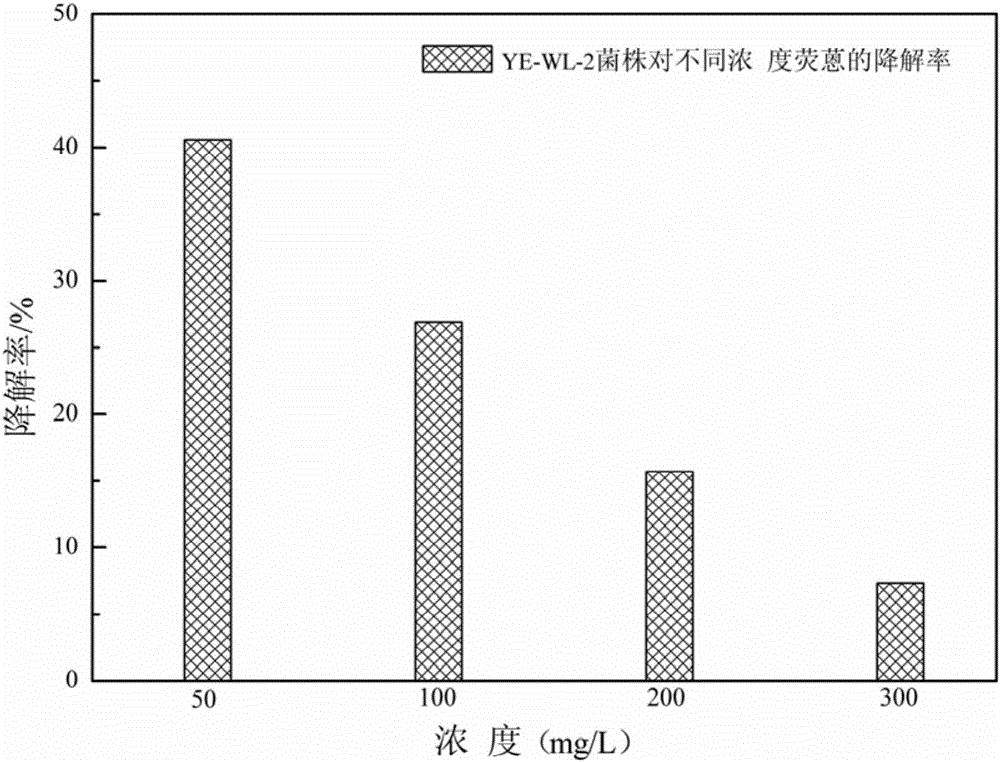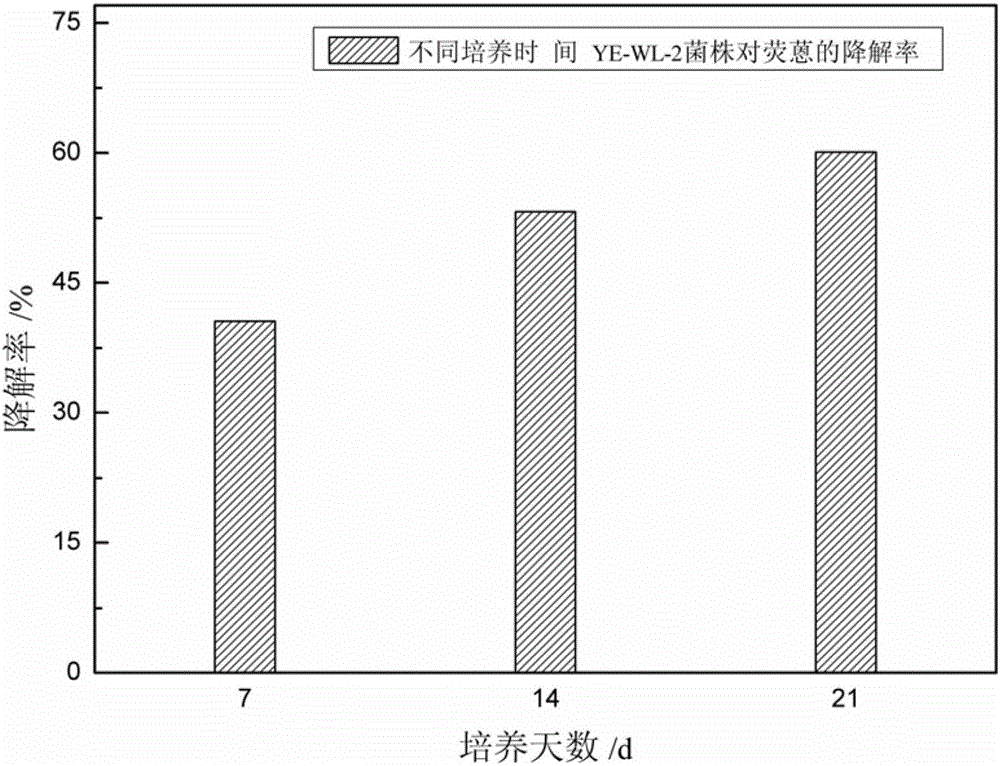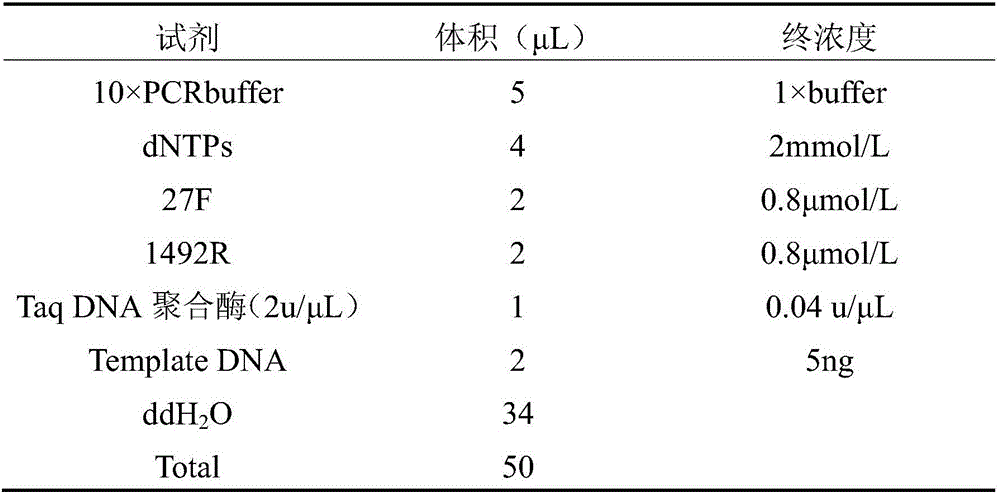Polycyclic aromatic hydrocarbon degrading bacterium and applications thereof
A polycyclic aromatic hydrocarbon and degrading bacteria technology, applied in the field of microorganisms, can solve the problems of high damage to the pollution system, high treatment cost, fast processing speed, etc., and achieves strong tolerance, good degradation effect, and is conducive to development and application. Effect
- Summary
- Abstract
- Description
- Claims
- Application Information
AI Technical Summary
Problems solved by technology
Method used
Image
Examples
Embodiment 1
[0031] Isolation and Identification of Rhodococcus YE-WL-2 Strain
[0032] (1) Because polycyclic aromatic hydrocarbons mainly exist in petroleum and coal, so coking wastewater contains more polycyclic aromatic hydrocarbons, Rhodococcus YE-WL-2 bacterial strain among the present invention adopts enrichment culture method from Shanxi Wulin Coking Plant The YE-WL-2 strain was isolated from the activated sludge of the aerobic tank, and the specific steps were as follows:
[0033] (1) Preparation of culture medium: Dissolve solid fluoranthene in acetone in advance, under aseptic conditions, add appropriate amount of fluoranthene mother liquor in a 250mL conical flask, wait for the acetone to volatilize completely, add sterilized inorganic salt medium .
[0034] The formula of inorganic salt medium is as follows: 0.9g / L KH 2 PO 4 , 6.5g / L Na 2 HPO 4 12H 2 O, 0.4g / L (NH 4 ) 2 SO 4 , 0.2g / L MgSO 4 ·7H 2 O, add 1mL trace element solution per 1L medium, (trace element soluti...
Embodiment 2
[0052] Physiological and Biochemical Characteristics of Rhodococcus YE-WL-2 Strain
[0053] (1), starch hydrolysis test
[0054] Culture medium preparation: add soluble starch to the broth medium composed of beef extract 3g / L, peptone 10g / / L, and NaCl 5g / L, so that the final concentration in the medium is 0.2%, add 2% agar , sterilized at 121°C for 20 minutes, poured into a plate under aseptic operation and set aside. Lugol's iodine solution: 1g iodine, 2g potassium iodide, first dissolve potassium iodide with a small amount of water, then add iodine tablets, after the iodine is completely dissolved, add water to dilute to 300ml. Spot the bacterial strains on a plate and culture at 30°C for 2-4 days. After colonies are formed, add Lugol's iodine solution dropwise on the plate to cover the colonies. Positive reaction (starch is hydrolyzed) is that the agar medium is dark blue, and a colorless transparent circle appears around the colony or culture; negative reaction means tha...
Embodiment 3
[0072]Determination of Degradation Rate of Different Concentrations of Fluoranthene by Rhodococcus YE-WL-2 Strain
[0073] Under the conditions of pH 7.0, temperature 30°C, and initial concentrations of fluoranthene of 50 mg / L, 100 mg / L, 200 mg / L, and 300 mg / L, the culture of YE-WL-2 strain was inoculated into 100 mL of the above-mentioned fluoranthene Anthracene is the only carbon source in the inorganic salt medium, shake culture at 150r / min for 7 days, extract with equal volume of ethyl acetate, evaporate to dryness by rotary evaporator, use methanol to make up the volume, and use high performance liquid chromatography to determine the content of the sample The content of residual fluoranthene was used to calculate the degradation rate. Take the initial concentration of fluoranthene as the abscissa, and draw the bar graph with the fluoranthene degradation rate as the ordinate, and the results are shown in figure 1 .
[0074] It can be seen from the figure that with the in...
PUM
| Property | Measurement | Unit |
|---|---|---|
| Tolerance concentration | aaaaa | aaaaa |
Abstract
Description
Claims
Application Information
 Login to View More
Login to View More - R&D
- Intellectual Property
- Life Sciences
- Materials
- Tech Scout
- Unparalleled Data Quality
- Higher Quality Content
- 60% Fewer Hallucinations
Browse by: Latest US Patents, China's latest patents, Technical Efficacy Thesaurus, Application Domain, Technology Topic, Popular Technical Reports.
© 2025 PatSnap. All rights reserved.Legal|Privacy policy|Modern Slavery Act Transparency Statement|Sitemap|About US| Contact US: help@patsnap.com



